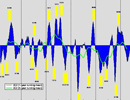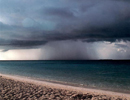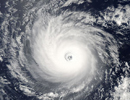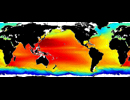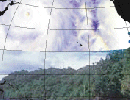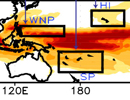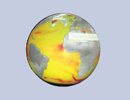Python
How to use the OPeNDAP server in Python.
The following explains the steps of loading data served by OPeNDAP using Python.
- Pick one of the three OPeNDAP servers to find the OPeNDAP URL.
- OPeNDAP URL general format describe as below.
- OPeNDAP URL:
http://apdrc.soest.hawaii.edu/dods/[directory(s)]/[dataset] - Authenticated OPeNDAP URL with username and password:
http://username:password@apdrc.soest.hawaii.edu/dods/[authenticated_directory(s)]/[dataset]
- OPeNDAP URL:
- Example in this tutorial using
- NLOM SSH 1/16deg Nowcast OPeNDAP URL:
http://apdrc.soest.hawaii.edu/dods/public_data/NLOM/nlom_ssh
- NLOM SSH 1/16deg Nowcast OPeNDAP URL:
Download and Install Python
with required external modules:
Or download and install Anaconda (Python 2.7)
with update/install external modules in command prompt:
- conda update pip
- conda update numpy
- conda update h5py
- conda update matplotlib
- conda install netcdf4
- conda install basemap
Open Python:
| In [1]: ...: ...: ...: ...: ...: ...: ...: ...: ...: ...: ...: ...: ...: ...: ...: ...: ...: ...: ...: ...: ...: ...: ...: ...: ...: ...: ...: ...: ...: ...: ...: ...: ...: ...: ...: ...: ...: |
from mpl_toolkits.basemap import Basemap from netCDF4 import Dataset, date2index import numpy as np import matplotlib.pyplot as plt from datetime import datetime # Contours ssh for specified time and space # Find the index for date Oct 3, 2004. date = datetime(2004,10,3,0) # Open dataset dataset = Dataset('http://apdrc.soest.hawaii.edu/dods/public_data/NLOM/nlom_ssh') timevar = dataset.variables['time'] timeindex = date2index(date,timevar) # find time index for desired date. # Read lats and lons (representing centers of grid boxes). lats = dataset.variables['lat'][:] lons = dataset.variables['lon'][:] # Find the indexes for 165W-153W, 18N-24N lat_bnds = [ 18 , 24 ] lon_bnds = [ -165+360 , -154+360 ] lat_inds = np.where((lats >= lat_bnds[0]) & (lats <= lat_bnds[1]))[0] lon_inds = np.where((lons >= lon_bnds[0]) & (lons <= lon_bnds[1]))[0] # Load the NLOM sea surface height from the above information ssh = dataset.variables['ssh'][timeindex,lat_inds,lon_inds].squeeze() # Create figure, axes instances. fig = plt.figure() ax = fig.add_axes([0.05,0.05,0.9,0.9]) # Create Basemap instance. m = Basemap(llcrnrlon=-165.,llcrnrlat=18.,urcrnrlon=-154.,urcrnrlat=24.,projection='mill') # Plot land outlines m.drawcoastlines() # Use subset of lats and lons sublons, sublats = np.meshgrid(lons[lon_inds]-360,lats[lat_inds]) # Contour sea surface height im1 = m.contourf(sublons, sublats, ssh, latlon=True) cb = m.colorbar(im1,"bottom", size="5%", pad="2%") ax.set_title('NLOM 1/16 degree Sea Surface Height [cm] October 3, 2004') plt.show() |

Using pcolormesh to plot:
| In [1]: ...: ...: ...: ...: ...: ...: ...: ...: ...: ...: ...: ...: ...: ...: ...: ...: ...: ...: ...: ...: ...: ...: ...: ...: ...: |
from mpl_toolkits.basemap import Basemap from netCDF4 import Dataset, date2index import numpy as np import matplotlib.pyplot as plt from datetime import datetime date = datetime(2000,1,1,0) # open dataset. dataset = Dataset('http://apdrc.soest.hawaii.edu/dods/public_data/SCUD/current') timevar = dataset.variables['time'] timeindex = date2index(date,timevar) # read u current uc = dataset.variables['uc'][timeindex,:].squeeze() lats = dataset.variables['lat'][:] lons = dataset.variables['lon'][:] lons, lats = np.meshgrid(lons,lats) # create figure, axes instances. fig = plt.figure() ax = fig.add_axes([0.05,0.05,0.9,0.9]) # create Basemap instance. m = Basemap(projection='mill',lon_0=180) m.drawcoastlines() im1 = m.pcolormesh(lons,lats,uc,latlon=True) cb = m.colorbar(im1,"bottom", size="5%", pad="2%") ax.set_title('SCUD u current for %s'%date) plt.show() |

Using Argo from ERDDAP (through APDRC Dapper):
Reference: http://matplotlib.org/basemap/users/examples.html
| In[1]: ...: ...: ...: ...: ...: ...: ...: ...: ...: ...: ...: ...: ...: ...: ...: ...: ...: ...: ...: ...: ...: ...: ...: ...: ...: ...: ...: ...: ...: |
from netCDF4 import Dataset, num2date import time, calendar, datetime, numpy from mpl_toolkits.basemap import Basemap import matplotlib.pyplot as plt import urllib, os # data downloaded from the form at # http://coastwatch.pfeg.noaa.gov/erddap/tabledap/apdrcArgoAll.html filename, headers = urllib.urlretrieve('http://coastwatch.pfeg.noaa.gov/erddap/tabledap/apdrcArgoAll.nc? longitude,latitude,time&longitude>=0&longitude<=360&latitude>=-90&latitude<=90&time>=2017-01-01&time<=2017-01-02&distinct()') dset = Dataset(filename) lats = dset.variables['latitude'][:] lons = dset.variables['longitude'][:] time = dset.variables['time'] times = time[:] t1 = times.min(); t2 = times.max() date1 = num2date(t1, units=time.units) date2 = num2date(t2, units=time.units) dset.close() os.remove(filename) # draw map with markers for float locations m = Basemap(projection='hammer',lon_0=180) x, y = m(lons,lats) m.drawmapboundary(fill_color='#99ffff') m.fillcontinents(color='#cc9966',lake_color='#99ffff') m.scatter(x,y,3,marker='o',color='k') plt.title('Locations of %s ARGO floats active between %s and %s' %\ (len(lats),date1,date2),fontsize=12) plt.show() |

Using FNMOC Indian Ocean from ERDDAP (through APDRC FNMOC):
| In[1]: ...: ...: ...: ...: ...: ...: ...: ...: ...: ...: ...: ...: ...: ...: ...: ...: ...: ...: ...: ...: ...: ...: ...: ...: ...: ...: ...: ...: ...: ...: ...: ...: ...: |
from netCDF4 import Dataset, num2date import time, calendar, datetime, numpy from mpl_toolkits.basemap import Basemap import matplotlib.pyplot as plt import urllib, os filename, headers = urllib.urlretrieve('http://apdrc.soest.hawaii.edu/erddap/tabledap/fnmoc_temperature_indian.nc?longitude,latitude,time,temperature&longitude>=0&longitude<=360&latitude>=-90&latitude<=90&time>=2014-01-01&time<=2014-01-31&distinct()') dset = Dataset(filename) lats = dset.variables['latitude'][:] lons = dset.variables['longitude'][:] time = dset.variables['time'] temps = dset.variables['temperature'][:] times = time[:] t1 = times.min(); t2 = times.max() date1 = num2date(t1, units=time.units) date2 = num2date(t2, units=time.units) dset.close() os.remove(filename) # draw map with markers for float locations m = Basemap(llcrnrlon=17.5,llcrnrlat=-59.17,urcrnrlon=133.37,urcrnrlat=29.88,projection='mill') x, y = m(lons,lats) m.drawmapboundary(fill_color='#99ffff') m.fillcontinents(color='#cc9966',lake_color='#99ffff') cm = plt.cm.get_cmap('jet') temp1 = temps.min(); temp2 = temps.max() sc = m.scatter(x,y,c=temps, vmin=temp1, vmax=temp2, s=5, cmap=cm) plt.colorbar(sc) plt.title('FNMOC Indian Ocean temperature active between %s and %s' %\ (date1,date2),fontsize=12) plt.show() |




